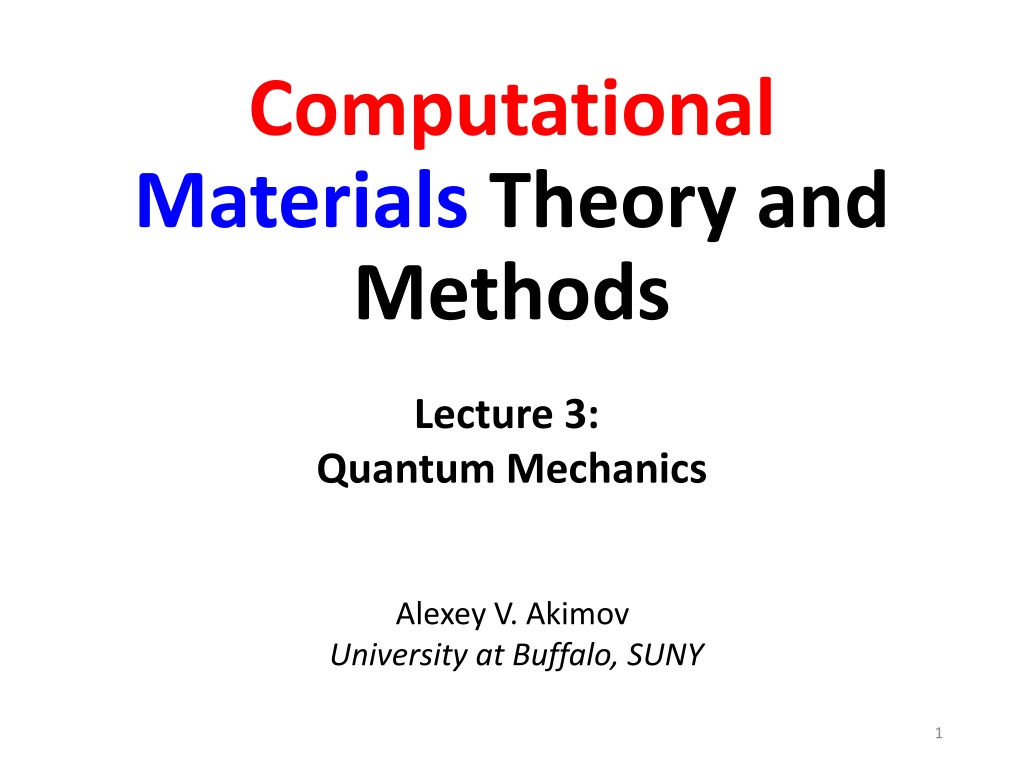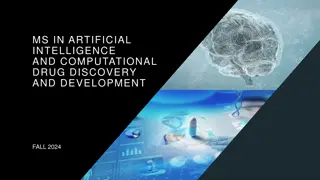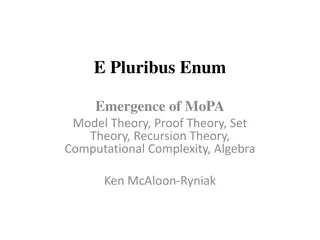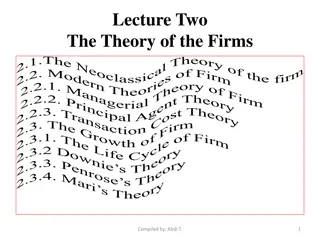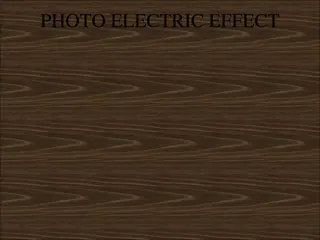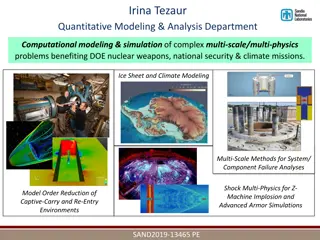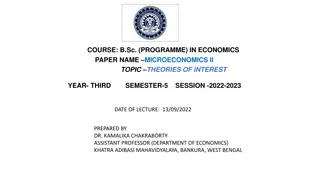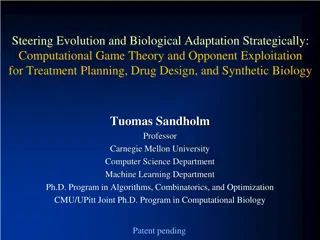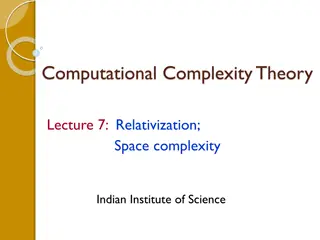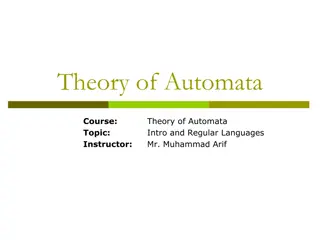Computational Materials Theory and Methods
This content delves into Quantum Mechanics Basics and Molecular Orbital Theory, discussing concepts like Atomic Orbitals, Basis Sets, and Wavefunction Components. It covers topics such as Slater-type Orbitals, Gaussian-type Orbitals, and Plane Waves in reciprocal and real space, focusing on their significance in computational materials theory and methods.
Download Presentation

Please find below an Image/Link to download the presentation.
The content on the website is provided AS IS for your information and personal use only. It may not be sold, licensed, or shared on other websites without obtaining consent from the author.If you encounter any issues during the download, it is possible that the publisher has removed the file from their server.
You are allowed to download the files provided on this website for personal or commercial use, subject to the condition that they are used lawfully. All files are the property of their respective owners.
The content on the website is provided AS IS for your information and personal use only. It may not be sold, licensed, or shared on other websites without obtaining consent from the author.
E N D
Presentation Transcript
Computational Materials Theory and Methods Lecture 3: Quantum Mechanics Alexey V. Akimov University at Buffalo, SUNY 1
Basics of the Molecular Orbital Theory ???? ??= ????,? Basis set expansion ?=1 ??? Orbitals: Molecular, crystal, etc. ??? ???? ???? = Basis functions: Atomic orbitals, plane- waves, etc. ???? ??? In general
Atomic orbitals Slater-type orbitals (STO): ??,?,?,??,?,? = ?????,? ?? 1? ?? Gaussian-type orbitals (GTO): ??,?,?,??,?,? = ??????????? ??2 where ??+ ??+ ??= ? STO-2G: ????= ?1????1+ ?2????2 Energy of electron in H atom Energy [hartree] 3/4 3/4 2?2 ? Basis set 2?1 ? ? ?2?2 ? ?1?2 ????2= ????1= STO-3G -0.49491 ?? ?? ?? ?? STO-2G STO-4G -0.49848 1s (C) 0.151623 0.678914 0.851819 0.430129 STO-5G -0.49951 2s (C) 0.0974545 0.963782 0.384244 0.0494718 STO-6G -0.49983 2p (C) 0.0974545 0.61282 0.384244 0.511541 Exact -0.5 Just for the radial component of wavefunction
Atomic orbitals Potential problems Where to get Basis set superposition error https://bse.pnl.gov/bse/portal Dissociation Linear dependence Pulay forces 4
Plane waves (PW) Reciprocal space unit cell Real space unit cell The bigger the size in real space, the smaller its counterpart in the reciprocal Unit cell volume = ? (? ?) Real space coordinate 1 ??? ??(?+?)? ??,?(?) = k-point vector (crystal momentum vector) ? Reciprocal space grid points Band ( orbital ) index 5
Plane waves (PW) pw convergence k-points convergence Kinetic energy of free electrons In DFT, many properties are given by: ? + ?2 2 ? = ???? ????= ? ???? ???? ? ? 6
Basis set comparisons Atomic basis PW basis Depends on the unit cell size, not the number of atoms Good for periodic systems Doesn t depend on the unit cell size Good for finite systems (clusters/molecules) Analytic integrals Massive linear algebra All-electron Needs a pseudopotential Basis set superposition error No BSSE Not systematically controllable Systematically controllable via k-points and ???? Linear dependence for large sets No problems with linear dependence Pulay forces No Pulay forces 7
Schrodinger equation ? ? ?? = ?? ??| ? |????,?= ?? |????,??? ,? = 1,2, ? ?=1 ?=1 Variational principle ? ? ? ? ? = ???? ??? Diabatic Hamiltonian (non-interacting basis) Adiabatic Hamiltonian (interacting basis) 8
Hierarchy of wavefunctions AO or PW (??) Primitive mathematical basis MO or Crystal orbitals: Solution to the mean-filed SE (1-electron functions) ??= ????,? ? Slater determinants: ??= ??? ??? Account for anti-symmetry (exchange/fermionic statistics) Account for correlation, proper spin symmetry Configuration interaction (CI), SAC-CI, MR-CI: ??= ????? 9
Constructing the Hamiltonian (in the AO basis) Fock (mean-filed) Hamiltonian ???,?= ???+ ???,? Core Hamiltonian Coulomb and Exchange Hamiltonian (does not depend on charge/spin density) (depends on charge/spin density) ???,?= ????? ?? ???,??? ?? ?? ? = ???? Density matrix Molecular integrals (depends on the solution of SE) 10
Dealing with the complexity of SE Approximations Scaling considerations Keep only the core part Solution of the eigenvalue problem: ?(???? 3) Replace the core with a special formula (TB- or extended H ckel) One-shot solution Construction of the integrals: ?(???? 4) Semiempirical methods: Simplify the 2-electron 4-center integrals, neglect some (CNDO, INDO, MNDO, etc. PMn) Need self-consistent solution Akimov, A. V.; Prezhdo, O. V. Chem. Rev.2015, 115, 5797 5890. 11
Extended Hckel theory (EHT) Simple math, efficient Clear meaning of parameters Consider it a Tight-Binding General-purpose (analog of UFF) No SCF required: 1-shot Hoffmann, R. J. Chem. Phys.1963, 39, 1397 1412. ??= ?1?1exp ??? + ?2?2exp ??? ???= ???? ???=??? Fancier schemes: SC-EHT Charge-dependent VSIP ???(???+ ???) 2 0 ??? ??= ?? Energy ??= VSIPa ?? Akimov, A. V.; Prezhdo, J. Math. Chem.2015, 53, 528 550. 12
Self-consistent field (SCF) Guess density matrix, ?0 Core Hamiltonian, ? Overlap matrix, ? Pre-compute integrals in AO basis Construct the Fock matrix ??= ? + ?(??) Density matrix, ?? Solve the eigenvalue problem: ????= ????? Update density matrix: ??+1= ?????? ? Compute the total energy : ??= ?? (??+ ??)?? Check the convergence: ?? 1 ?? < ????? ?? 1 ?? < ??? Done 13
